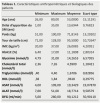Type 1 Diabetes and Metabolic Syndrome: Exploring a Complex Relationship
- PMID: 39748689
- PMCID: PMC11770789
- DOI: 10.62438/tunismed.v102i12.4916
Type 1 Diabetes and Metabolic Syndrome: Exploring a Complex Relationship
Abstract
Introduction: Metabolic syndrome (MS) is responsible for the increased cardiovascular risk in patients with type 2 diabetes. Few studies have focused on MS in type 1 diabetes mellitus (T1DM).
Aim: To describe the clinical, biochemical and therapeutic characteristics of T1DM patients affected by MS.
Methods: A retrospective study was carried out. It included 36 patients, suffering from T1DM and MS, hospitalized in the Endocrinology-Diabetology Department of the Hédi Chaker University Hospital of Sfax-Tunisia, from 1997 to 2020. MS was defined according to the NCEP-ATP III criteria.
Results: The mean age of the patients was 53 years. The mean duration of diabetes was 15 years. The MS appeared after a mean duration of diabetes of 13.7 years. Hypertension was reported in 21 patients (58.3%). The mean BMI was 26 kg/m2. The mean total cholesterol level was 4.59 mmol/l ±1.18, and the mean triglycerides level was 1.67 mmol/l ±0.81. The mean HDL-cholesterol level was 0.96 mmol/l ±0.29. In the majority of cases (80%), MS was the combination of dyslipidemia, hypertension and diabetes. Therapeutically, the average dose of insulin used was 0.8 IU/kg/day. The combination of metformin was necessary in 18 cases (50%). Microvascular complications were present in all patients. The cardiovascular risk was very high in all patients.
Conclusion: The prevalence of MS during T1DM is increasing. It indicates an increased risk of micro and macrovascular complications.
Introduction: Le syndrome métabolique (SM) est responsable de l'augmentation du risque cardiovasculaire chez les patients présentant un diabète de type 2. Peu d'études se sont intéressées au SM chez les diabétiques de type 1 (DT1). Objectif: Décrire les caractéristiques cliniques, biochimiques et thérapeutiques des DT1 atteints du SM. Méthodes: Une étude rétrospective a été réalisée. Elle a inclus 36 patients, atteints de DT1 et de SM, hospitalisés dans le Service d'Endocrinologie Diabétologie du CHU Hédi Chaker de Sfax-Tunisie, de 1997 à 2020. Le SM a été défini selon les critères NCEP-ATP III. Résultats: L'âge moyen des patients était de 53 ans. La durée moyenne du diabète était de 15 ans. Le SM est apparu après une durée moyenne du diabète de 13,7 ans. Une HTA a été rapportée chez 21 patients (58,3%). L'IMC moyen était de 26 kg/m2. Le taux moyen de cholestérol total était de 4,59 mmol/l±1,18, celui des triglycérides de 1,67 mmol/l±0,81. Le taux moyen d’HDL-cholestérol était de 0,96 mmol/l±0,29. Dans la majorité des cas (80%), le SM s'agissait de l'association d'une dyslipidémie, d'une HTA et d'un diabète. Sur le plan thérapeutique, la dose moyenne d'insuline utilisée était de 0,8 UI/kg/jour. L'association de metformine a été nécessaire dans 18 cas (50%). Les complications microvasculaires étaient présentes chez tous les patients. Le risque cardiovasculaire était très élevé chez tous les patients. Conclusion: La prévalence du SM au cours du DT1 est en augmentation. Il indique un risque accru de complications micro et macrovasculaires.
Keywords: Cardiovascular risk; Metabolic syndrome; Type 1 diabetes mellitus.
Figures
References
-
- Eckel RH. Harrison’s Principles of Internal Medicine. 20e éd. McGraw-Hill Education; New York, NY: 2018. The Metabolic Syndrome. https://accessmedicine.mhmedical.com/content.aspx?aid=1183992857 [cité 26 août 2024]
-
- Alberti KGMM, Eckel RH, Grundy SM, Zimmet PZ, Cleeman JI, Donato KA, et al. Harmonizing the metabolic syndrome: a joint interim statement of the International Diabetes Federation Task Force on Epidemiology and Prevention; National Heart, Lung, and Blood Institute; American Heart Association; World Heart Federation; International Atherosclerosis Society; and International Association for the Study of Obesity. Circulation. 2009 oct;120(16):1640–1645. - PubMed
-
- Mach F, Baigent C, Catapano AL, Koskinas KC, Casula M, Badimon L, et al. 2019 ESC/EAS Guidelines for the management of dyslipidaemias: lipid modification to reduce cardiovascular risk. Eur Heart J. 2020 janv;41(1):111–188. - PubMed
-
- Lee AS, Twigg SM, Flack JR. Metabolic syndrome in type 1 diabetes and its association with diabetes complications. Diabet Med J Br Diabet Assoc. 2021 févr;38(2):e14376. - PubMed
Publication types
MeSH terms
Substances
LinkOut - more resources
Full Text Sources
Medical


